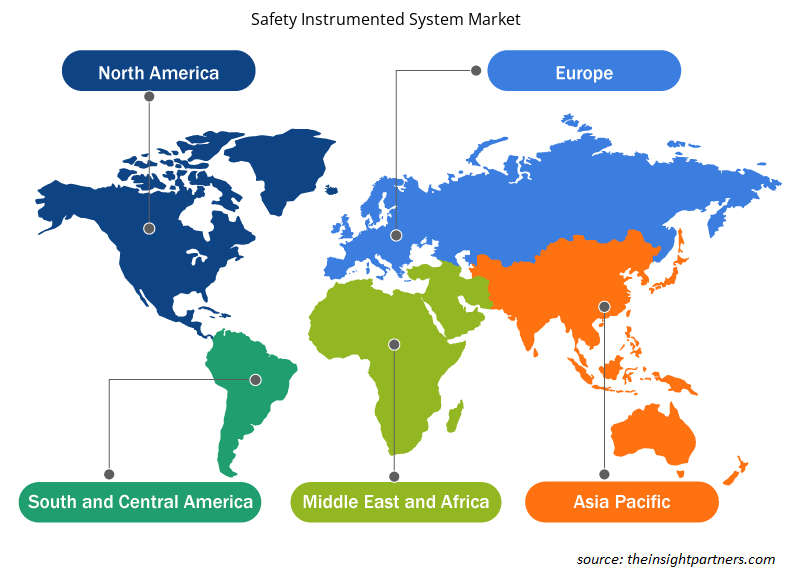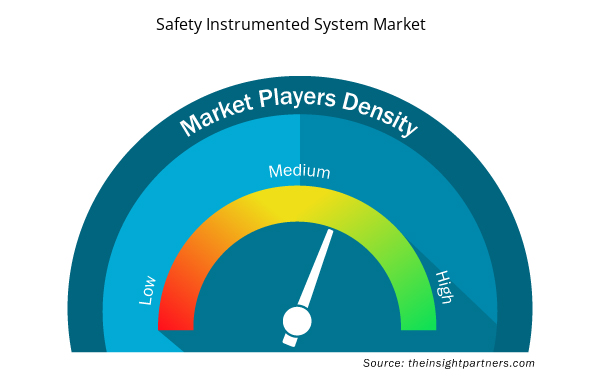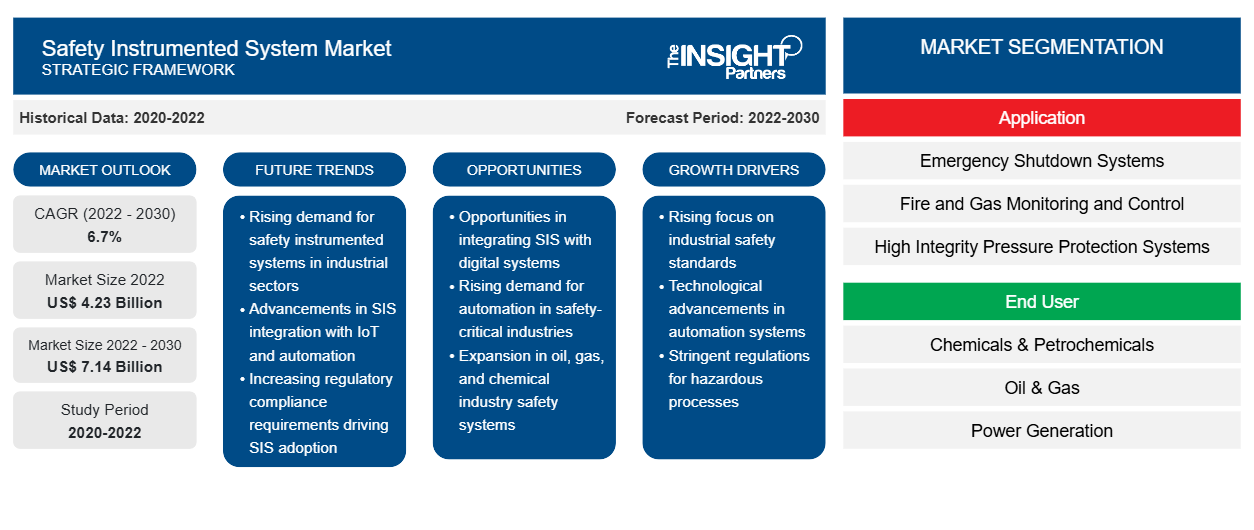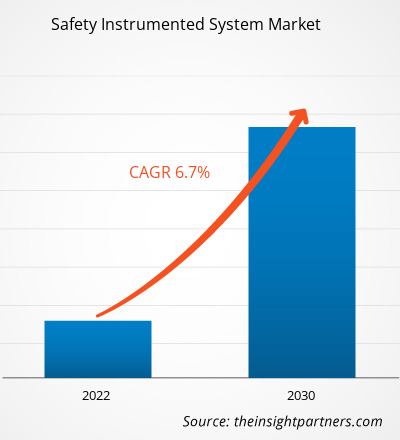[Forschungsbericht] Der Markt für sicherheitsrelevante Systeme soll von 4,23 Milliarden US-Dollar im Jahr 2022 auf 7,14 Milliarden US-Dollar im Jahr 2030 wachsen; von 2022 bis 2030 wird eine durchschnittliche jährliche Wachstumsrate (CAGR) von 6,7 % erwartet.
Analystenperspektive:
Der Bau neuer Öl- und Gasraffinerien und die wachsenden Bergbauaktivitäten weltweit sind die Hauptfaktoren, die das Wachstum des Marktes für sicherheitsgerichtete Systeme vorantreiben . Auch die zunehmende Einführung von Sicherheitsvorschriften und -standards fördert das Wachstum des Marktes für sicherheitsgerichtete Systeme. Darüber hinaus schafft die zunehmende industrielle Automatisierung in der Chemie- und Petrochemieindustrie zur Steigerung der Effizienz und Sicherheit der Mitarbeiter weitere Möglichkeiten für das Wachstum des Marktes für sicherheitsgerichtete Systeme. Das wachsende Sicherheitsbewusstsein in verschiedenen Branchen beschleunigt die Expansion des Marktes für sicherheitsgerichtete Systeme weiter.
Marktübersicht:
In vielen Prozessanlagen wird ein Sicherheitsinstrumentensystem (SIS) eingesetzt, da es dabei hilft, bei anormalen Bedingungen automatisierte Maßnahmen zu ergreifen, um eine Anlage in einem sicheren Zustand zu halten. Im Falle einer Störung, die zu einem unglücklichen Zwischenfall führen kann, bringt das SIS den Prozess automatisch in einen sicheren Zustand und hilft, Todesfälle, Sachschäden und Umweltschäden zu verhindern. An verschiedenen Betriebsstandorten in der Öl- und Gasindustrie, der Chemie und anderen Industrien, die mit schweren Maschinen und Chemikalien arbeiten, können mehrere katastrophale Ereignisse auftreten. Diese können von Bränden bis hin zu Lecks reichen, die zu Explosionen führen können, und der Bedarf an High-End-Sicherheitssystemen wie SIS steigt weltweit.
Passen Sie diesen Bericht Ihren Anforderungen an
Sie erhalten kostenlose Anpassungen an jedem Bericht, einschließlich Teilen dieses Berichts oder einer Analyse auf Länderebene, eines Excel-Datenpakets sowie tolle Angebote und Rabatte für Start-ups und Universitäten.
- Holen Sie sich die wichtigsten Markttrends aus diesem Bericht.Dieses KOSTENLOSE Beispiel umfasst eine Datenanalyse von Markttrends bis hin zu Schätzungen und Prognosen.
Markttreiber:
Steigende Expansion der Öl- und Gasindustrie treibt Marktwachstum für sicherheitsinstrumentierte Systeme voran
Die USA sind einer der größten Erdgasproduzenten der Welt. Nach Angaben der US Energy Information Administration (EIA) produzierte das Land im Jahr 2021 etwa 34.517.798 Millionen Kubikfuß (MMcf) Erdgas und verbrauchte 30.664.951 MMcf Erdgas. Das Land exportierte außerdem 3.560.818 MMcf Flüssigerdgas (LNG). Weltweit sind auch verschiedene neue Öl- und Gasbauprojekte im Gange. Im zweiten Quartal 2022 begannen die Bauarbeiten für das Projekt Centre of Excellence for Carbon Capture & Removal in Burnaby, British Columbia, Kanada. Dabei handelte es sich um den Bau einer CCS-Anlage, die dabei hilft, bis zu 2.000 Tonnen CO2 pro Tag abzufangen und zu speichern. Ebenso begann im zweiten Quartal 2022 der Bau des Projekts Vista Pacifico Liquified Natural Gas Plant mit einer Investition von 2.000 Millionen US-Dollar. Im Rahmen dieses Projekts wird auf 150 Hektar in der Gemeinde Ahome, Topolobampo, Sinaloa, Mexiko, ein LNG-Exportterminal errichtet. Solche Öl- und Gasbauprojekte werden daher die Nachfrage nach Sicherheitssystemen ankurbeln.
Darüber hinaus erreichte die schwedische Erzproduktion laut dem Bericht „Statistik der schwedischen Bergbauindustrie 2021“ im Jahr 2021 88,6 Millionen Tonnen, ein Anstieg von 22 % seit 2015. Laut dem australischen Statistikamt stieg die Bergbauproduktion in Australien im ersten Quartal 2023 um 5,7 %. Daher wird erwartet, dass die weltweit wachsende Bergbauproduktion die Nachfrage nach Sicherheit und Überwachung ansteigen lässt, um die Sicherheit von Mitarbeitern, Geräten oder Materialien zu gewährleisten. Dieser steigende Bedarf an sicherheitsgerichteten Systemen fördert das Wachstum des Marktes für sicherheitsgerichtete Systeme weiter.
Berichtssegmentierung und -umfang:
Der Markt für Sicherheitsinstrumentierungssysteme ist nach Anwendung, Endbenutzer und Geografie segmentiert. Basierend auf der Anwendung ist der Markt für Sicherheitsinstrumentierungssysteme in Notabschaltsysteme, Brand- und Gasüberwachung und -kontrolle, hochintegrierte Druckschutzsysteme, Brennermanagementsysteme und Turbomaschinensteuerung unterteilt. Nach Endbenutzer ist der Markt für Sicherheitsinstrumentierungssysteme in Chemie und Petrochemie, Öl und Gas, Stromerzeugung, Pharmazie, Lebensmittel und Getränke und andere unterteilt. Geografisch ist der Markt für Sicherheitsinstrumentierungssysteme in Nordamerika, Europa, Asien-Pazifik (APAC), Naher Osten und Afrika (MEA) und Südamerika (SAM) segmentiert.
Segmentanalyse:
Basierend auf der Anwendung ist der Markt für sicherheitsgerichtete Systeme in Notabschaltungssysteme, Brand- und Gasüberwachung und -steuerung, hochintegrierte Druckschutzsysteme, Brennermanagementsysteme und Turbomaschinensteuerung unterteilt. Das Segment der Notabschaltungssysteme hatte 2022 den größten Marktanteil an sicherheitsgerichteten Systemen und wird voraussichtlich zwischen 2022 und 2030 die höchste durchschnittliche jährliche Wachstumsrate verzeichnen. Die Notabschaltungssysteme (ESD) sind hochzuverlässige Steuerungssysteme für Hochrisikobranchen wie Öl und Gas sowie Kernkraft mit Explosionsgefahr. Das System hilft beim Schutz von Personal, Anlagen und Umwelt, falls der Prozess die Kontrollmargen überschreitet.
Regionale Analyse:
Der asiatisch-pazifische Raum hatte 2022 den größten Marktanteil bei Sicherheitsinstrumentensystemen. Die Region erlebt ein enormes Wachstum in der Chemie- und Pharmaindustrie. Die Marktteilnehmer in dieser Region arbeiten kontinuierlich an der Erweiterung ihrer Produktionsanlagen. So gab Balaxi Pharmaceuticals im Dezember 2022 bekannt, dass sie mit dem Bau einer neuen Arzneimittelproduktionsanlage in Telangana, Indien, begonnen haben. Das Unternehmen investierte in dieses Projekt rund 10,29 Millionen US-Dollar (85 Crore INR). Die neue Produktionsanlage wird dem Unternehmen helfen, in die europäischen Märkte einzutreten und die Margen in den bestehenden Märkten zu verbessern. Ebenso kündigte Hanwha Corp. im September 2021 seinen Plan an, bis 2024 eine Anlage zur Produktion von Salpetersäure zu bauen. Diese Anlage wird eine Jahreskapazität von 400.000 Tonnen im südkoreanischen Industriekomplex Yeosu haben. Dafür wird das Unternehmen 162 Millionen US-Dollar (190 Milliarden Won) investieren.
Somit wird die steigende Zahl neuer Produktionsanlagen in der Region die Nachfrage nach sicherheitsgerichteten Systemen steigern, da sie dazu beitragen, Unfälle im Werk zu verhindern und so das Wachstum des Marktes für sicherheitsgerichtete Systeme vorantreiben.
Schlüsselspieleranalyse:
ABB Ltd, Applied Control Engineering Inc, AVEVA Group plc, Emerson Electric Co, HIMA, Honeywell International, Rockwell Automation Inc, Schneider Electric, Siemens AG und Yokogawa Electric Corporation sind die wichtigsten Akteure auf dem Markt für sicherheitsgerichtete Systeme, die im Bericht porträtiert werden.
Regionale Einblicke in den Markt für sicherheitsinstrumentierte Systeme
Die regionalen Trends und Faktoren, die den Markt für Sicherheitsinstrumentierungssysteme während des gesamten Prognosezeitraums beeinflussen, wurden von den Analysten von Insight Partners ausführlich erläutert. In diesem Abschnitt werden auch die Marktsegmente und die Geografie von Sicherheitsinstrumentierungssystem in Nordamerika, Europa, im asiatisch-pazifischen Raum, im Nahen Osten und Afrika sowie in Süd- und Mittelamerika erörtert.

- Erhalten Sie regionale Daten zum Markt für sicherheitsgerichtete Systeme
Umfang des Marktberichts zu sicherheitsinstrumentierten Systemen
| Berichtsattribut | Details |
|---|---|
| Marktgröße im Jahr 2022 | 4,23 Milliarden US-Dollar |
| Marktgröße bis 2030 | 7,14 Milliarden US-Dollar |
| Globale CAGR (2022 - 2030) | 6,7 % |
| Historische Daten | 2020-2022 |
| Prognosezeitraum | 2022–2030 |
| Abgedeckte Segmente | Nach Anwendung
|
| Abgedeckte Regionen und Länder | Nordamerika
|
| Marktführer und wichtige Unternehmensprofile |
|
Marktteilnehmerdichte: Der Einfluss auf die Geschäftsdynamik
Der Markt für Sicherheitsinstrumentierungssysteme wächst rasant, angetrieben durch die steigende Nachfrage der Endnutzer aufgrund von Faktoren wie sich entwickelnden Verbraucherpräferenzen, technologischen Fortschritten und einem größeren Bewusstsein für die Vorteile des Produkts. Mit steigender Nachfrage erweitern Unternehmen ihr Angebot, entwickeln Innovationen, um die Bedürfnisse der Verbraucher zu erfüllen, und nutzen neue Trends, was das Marktwachstum weiter ankurbelt.
Die Marktteilnehmerdichte bezieht sich auf die Verteilung von Firmen oder Unternehmen, die in einem bestimmten Markt oder einer bestimmten Branche tätig sind. Sie gibt an, wie viele Wettbewerber (Marktteilnehmer) in einem bestimmten Marktraum im Verhältnis zu seiner Größe oder seinem gesamten Marktwert präsent sind.
Die wichtigsten auf dem Markt für sicherheitsgerichtete Systeme tätigen Unternehmen sind:
- ABB Ltd
- Angewandte Steuerungstechnik GmbH
- AVEVA Gruppe plc
- Emerson Electric Co
- HIMA, Honeywell International
Haftungsausschluss : Die oben aufgeführten Unternehmen sind nicht in einer bestimmten Reihenfolge aufgeführt.

- Überblick über die wichtigsten Akteure auf dem Markt für sicherheitsgerichtete Systeme
Aktuelle Entwicklungen:
Die Akteure auf dem Markt für Sicherheitsinstrumente setzen in hohem Maße auf anorganische und organische Strategien. Nachfolgend sind einige aktuelle wichtige Marktentwicklungen aufgeführt:
- Im Mai 2022 stellte Emerson das TopWorxTM DX PST mit HART 7 vor. Die Einheiten liefern wertvolle Ventildaten und Diagnoseinformationen und ermöglichen so die digitale Transformation von Prozessanwendungen. Das neue DX PST lässt sich nahtlos in vorhandene Ventile und Steuerungssysteme integrieren und bietet Bedienern Zugriff auf wichtige Ventildaten, Trends und Diagnosen, die zur Vorhersage und Planung von Wartungsarbeiten verwendet werden können. Das DX PST erfüllt Sicherheitsintegritätslevel 3 (SIL 3) und ist mit einer integrierten 2oo2- oder 2oo3-Magnetventilredundanz erhältlich, wenn es mit dem Advanced Redundant Control System (ARCS) der ASCOTM-Serie gepaart wird, um die Sicherheit weiter zu verbessern, und offenen Anschlüssen, die einen zusätzlichen Drucktransmitter zusammen mit zwei Druckschaltern ermöglichen.
- Im März 2022 erhielt INTECH einen Auftrag zur Bereitstellung eines hochintegrierten Druckschutzsystems (HIPPS) zum Schutz der Ölförderinfrastruktur in einem großen Ölfeld im Nahen Osten. Im Rahmen dieses Vertrags suchten Ölfeldunternehmen im Nahen Osten die Expertise von INTECH zur Herstellung und Installation von IOPPS-Paketen hinter den Verteilern, um Hauptleitungen und Entgasungsstationen vor potenziellem Überdruck zu schützen.
- Im November 2020 brachte ABB Ability Safety Plus für Förderanlagen auf den Markt, eine Reihe von Sicherheitsprodukten für Förderanlagen, die der Bergbauindustrie das höchste Maß an Sicherheit für Personal und Ausrüstung bieten. Zu den Produkten gehören Safety Plus Hoist Monitor (SPHM), Safety Plus Hoist Protector (SPHP) und Safety Plus Brake System (SPBS), einschließlich Sicherheitsbremshydraulik (SBH).
- Historische Analyse (2 Jahre), Basisjahr, Prognose (7 Jahre) mit CAGR
- PEST- und SWOT-Analyse
- Marktgröße Wert/Volumen – Global, Regional, Land
- Branche und Wettbewerbsumfeld
- Excel-Datensatz



Report Coverage
Revenue forecast, Company Analysis, Industry landscape, Growth factors, and Trends

Segment Covered
This text is related
to segments covered.

Regional Scope
North America, Europe, Asia Pacific, Middle East & Africa, South & Central America

Country Scope
This text is related
to country scope.
Häufig gestellte Fragen
The US held the largest safety instrumented system market share in 2022.
The incremental growth expected to be recorded for the safety instrumented system market during the forecast period is US$ 2.90 billion.
Rising expansion in oil & gas industry and growing adoption of safety regulations and standards are the major factors that propel the safety instrumented system market.
The key players holding majority shares in the safety instrumented system market are Rockwell Automation Inc, Honeywell International, Emerson Electric Co, Yokogawa Electric Corporation, and ABB Ltd.
Asia Pacific is anticipated to grow with the highest CAGR over the forecast period.
The Safety instrumented system market is expected to reach US$ 7.14 billion by 2030.
Growing awareness of safety across different industries is anticipated to play a significant role in the safety instrumented system market in the coming years.
The safety instrumented system market was estimated to be US$ 4.23 billion in 2022 and is expected to grow at a CAGR of 6.7 % during the forecast period 2023 - 2030.
Trends and growth analysis reports related to Electronics and Semiconductor : READ MORE..
The List of Companies - Safety Instrumented System Market
- ABB Ltd
- Applied Control Engineering Inc
- AVEVA Group plc
- Emerson Electric Co
- HIMA, Honeywell International
- Rockwell Automation Inc
- Schneider Electric
- Siemens AG
- Yokogawa Electric Corporation
The Insight Partners performs research in 4 major stages: Data Collection & Secondary Research, Primary Research, Data Analysis and Data Triangulation & Final Review.
- Data Collection and Secondary Research:
As a market research and consulting firm operating from a decade, we have published and advised several client across the globe. First step for any study will start with an assessment of currently available data and insights from existing reports. Further, historical and current market information is collected from Investor Presentations, Annual Reports, SEC Filings, etc., and other information related to company’s performance and market positioning are gathered from Paid Databases (Factiva, Hoovers, and Reuters) and various other publications available in public domain.
Several associations trade associates, technical forums, institutes, societies and organization are accessed to gain technical as well as market related insights through their publications such as research papers, blogs and press releases related to the studies are referred to get cues about the market. Further, white papers, journals, magazines, and other news articles published in last 3 years are scrutinized and analyzed to understand the current market trends.
- Primary Research:
The primarily interview analysis comprise of data obtained from industry participants interview and answers to survey questions gathered by in-house primary team.
For primary research, interviews are conducted with industry experts/CEOs/Marketing Managers/VPs/Subject Matter Experts from both demand and supply side to get a 360-degree view of the market. The primary team conducts several interviews based on the complexity of the markets to understand the various market trends and dynamics which makes research more credible and precise.
A typical research interview fulfils the following functions:
- Provides first-hand information on the market size, market trends, growth trends, competitive landscape, and outlook
- Validates and strengthens in-house secondary research findings
- Develops the analysis team’s expertise and market understanding
Primary research involves email interactions and telephone interviews for each market, category, segment, and sub-segment across geographies. The participants who typically take part in such a process include, but are not limited to:
- Industry participants: VPs, business development managers, market intelligence managers and national sales managers
- Outside experts: Valuation experts, research analysts and key opinion leaders specializing in the electronics and semiconductor industry.
Below is the breakup of our primary respondents by company, designation, and region:

Once we receive the confirmation from primary research sources or primary respondents, we finalize the base year market estimation and forecast the data as per the macroeconomic and microeconomic factors assessed during data collection.
- Data Analysis:
Once data is validated through both secondary as well as primary respondents, we finalize the market estimations by hypothesis formulation and factor analysis at regional and country level.
- Macro-Economic Factor Analysis:
We analyse macroeconomic indicators such the gross domestic product (GDP), increase in the demand for goods and services across industries, technological advancement, regional economic growth, governmental policies, the influence of COVID-19, PEST analysis, and other aspects. This analysis aids in setting benchmarks for various nations/regions and approximating market splits. Additionally, the general trend of the aforementioned components aid in determining the market's development possibilities.
- Country Level Data:
Various factors that are especially aligned to the country are taken into account to determine the market size for a certain area and country, including the presence of vendors, such as headquarters and offices, the country's GDP, demand patterns, and industry growth. To comprehend the market dynamics for the nation, a number of growth variables, inhibitors, application areas, and current market trends are researched. The aforementioned elements aid in determining the country's overall market's growth potential.
- Company Profile:
The “Table of Contents” is formulated by listing and analyzing more than 25 - 30 companies operating in the market ecosystem across geographies. However, we profile only 10 companies as a standard practice in our syndicate reports. These 10 companies comprise leading, emerging, and regional players. Nonetheless, our analysis is not restricted to the 10 listed companies, we also analyze other companies present in the market to develop a holistic view and understand the prevailing trends. The “Company Profiles” section in the report covers key facts, business description, products & services, financial information, SWOT analysis, and key developments. The financial information presented is extracted from the annual reports and official documents of the publicly listed companies. Upon collecting the information for the sections of respective companies, we verify them via various primary sources and then compile the data in respective company profiles. The company level information helps us in deriving the base number as well as in forecasting the market size.
- Developing Base Number:
Aggregation of sales statistics (2020-2022) and macro-economic factor, and other secondary and primary research insights are utilized to arrive at base number and related market shares for 2022. The data gaps are identified in this step and relevant market data is analyzed, collected from paid primary interviews or databases. On finalizing the base year market size, forecasts are developed on the basis of macro-economic, industry and market growth factors and company level analysis.
- Data Triangulation and Final Review:
The market findings and base year market size calculations are validated from supply as well as demand side. Demand side validations are based on macro-economic factor analysis and benchmarks for respective regions and countries. In case of supply side validations, revenues of major companies are estimated (in case not available) based on industry benchmark, approximate number of employees, product portfolio, and primary interviews revenues are gathered. Further revenue from target product/service segment is assessed to avoid overshooting of market statistics. In case of heavy deviations between supply and demand side values, all thes steps are repeated to achieve synchronization.
We follow an iterative model, wherein we share our research findings with Subject Matter Experts (SME’s) and Key Opinion Leaders (KOLs) until consensus view of the market is not formulated – this model negates any drastic deviation in the opinions of experts. Only validated and universally acceptable research findings are quoted in our reports.
We have important check points that we use to validate our research findings – which we call – data triangulation, where we validate the information, we generate from secondary sources with primary interviews and then we re-validate with our internal data bases and Subject matter experts. This comprehensive model enables us to deliver high quality, reliable data in shortest possible time.


 Holen Sie sich ein kostenloses Muster für diesen Bericht
Holen Sie sich ein kostenloses Muster für diesen Bericht